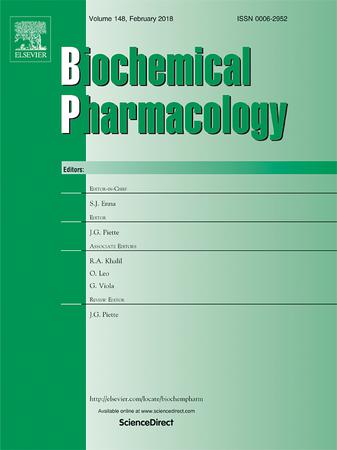胰岛β细胞在健康和代谢应激中的功能。
IF 5.3
2区 医学
Q1 PHARMACOLOGY & PHARMACY
引用次数: 0
摘要
蛋白质前酰化涉及多种细胞功能,包括细胞骨架重塑、运输和分泌囊泡与质膜的融合。它涉及将甲羟戊酸的15碳法尼基或20碳香叶基衍生物结合到底物蛋白质c端的半胱氨酸中。至少有四种戊烯基转移酶,即法尼基转移酶(FTase)和香叶基转移酶I-III (GGTase-I、II和III)已在哺乳动物细胞中被鉴定出来。已发表的证据表明,这些戊烯基转移酶及其候选底物蛋白的功能活性形式在人胰岛、啮齿动物胰岛和克隆β细胞中表达。药理学和分子生物学证据表明,蛋白质戊烯酰化在葡萄糖刺激胰岛素分泌中起着必要的作用。也有证据表明,在胰岛素分泌受损和糖尿病的β细胞模型中,蛋白前酰体存在显著缺陷。本文将对胰岛β细胞正常健康状态下蛋白质前置酰化的调节作用、参与该信号通路的酶、它们的结构组成和调控进行综述。此外,本文还综述了长期暴露于致糖尿病刺激下胰腺β细胞中蛋白戊烯酰化途径代谢命运的实验证据。最后,强调了我们目前对胰岛生物学领域的理解的关键差距和未来研究的潜在机会。本文章由计算机程序翻译,如有差异,请以英文原文为准。
Protein prenylation in islet β-cell function in health and metabolic stress
Protein prenylation has been implicated in a variety of cellular functions, including cytoskeletal remodeling, trafficking and fusion of secretory vesicles with the plasma membrane. It involves incorporation of either a 15-carbon farnesyl or a 20-carbon geranylgeranyl derivative of mevalonic acid into cysteines at the C-terminus of substrate proteins. At least four types of prenyltransferases, namely farnesyl transferase (FTase) and the geranylgeranyl transferases I-III (GGTase-I, II, and III) have been identified in mammalian cells. Published evidence suggests expression of functionally active forms of these prenyltransferases and their candidate substrate proteins in human islets, rodent islets, and clonal β-cells. Pharmacological and molecular biological evidence implicates requisite roles for protein prenylation in glucose-stimulated insulin secretion. Evidence is also emerging to indicate significant defects in protein prenylome in β-cell models of impaired insulin secretion and diabetes. This review will provide a status update on modulatory roles of protein prenylation, enzymes involved in this signaling pathway, their structural composition and regulation in the context of islet β-cell function in normal health. In addition, experimental evidence on the metabolic fate of protein prenylation pathway in the pancreatic β-cell following chronic exposure to diabetogenic stimuli is reviewed herein. Lastly, crucial gaps in our current understanding, and potential opportunities for future research in this area of islet biology are highlighted.
求助全文
通过发布文献求助,成功后即可免费获取论文全文。
去求助
来源期刊

Biochemical pharmacology
医学-药学
CiteScore
10.30
自引率
1.70%
发文量
420
审稿时长
17 days
期刊介绍:
Biochemical Pharmacology publishes original research findings, Commentaries and review articles related to the elucidation of cellular and tissue function(s) at the biochemical and molecular levels, the modification of cellular phenotype(s) by genetic, transcriptional/translational or drug/compound-induced modifications, as well as the pharmacodynamics and pharmacokinetics of xenobiotics and drugs, the latter including both small molecules and biologics.
The journal''s target audience includes scientists engaged in the identification and study of the mechanisms of action of xenobiotics, biologics and drugs and in the drug discovery and development process.
All areas of cellular biology and cellular, tissue/organ and whole animal pharmacology fall within the scope of the journal. Drug classes covered include anti-infectives, anti-inflammatory agents, chemotherapeutics, cardiovascular, endocrinological, immunological, metabolic, neurological and psychiatric drugs, as well as research on drug metabolism and kinetics. While medicinal chemistry is a topic of complimentary interest, manuscripts in this area must contain sufficient biological data to characterize pharmacologically the compounds reported. Submissions describing work focused predominately on chemical synthesis and molecular modeling will not be considered for review.
While particular emphasis is placed on reporting the results of molecular and biochemical studies, research involving the use of tissue and animal models of human pathophysiology and toxicology is of interest to the extent that it helps define drug mechanisms of action, safety and efficacy.
 求助内容:
求助内容: 应助结果提醒方式:
应助结果提醒方式:


